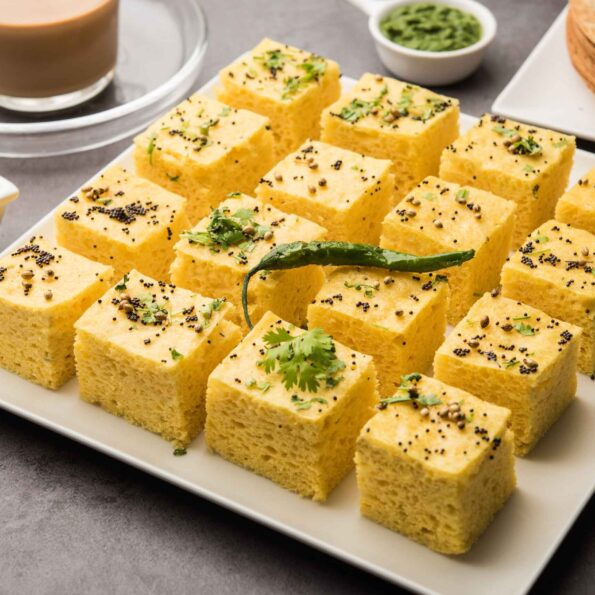Instant Khaman Dhokla Recipe- Gujarathi Style

What is Dhokla?
Dhokla is a popular steamed snack from Gujarat, India, made primarily from fermented batter of gram flour (besan) or rice and lentils. It is light, spongy, and slightly tangy, often flavored with spices and tempering. Dhokla can be eaten as a snack, breakfast, or even a side dish. It's typically served with green chutney or sweet tamarind chutney, and its fluffy texture makes it a favorite among all ages. There are various versions, such as Khaman Dhokla, Rava Dhokla, and White Dhokla, each offering a unique taste and preparation style.
Dhokla Is Famous in Which State?
Dhokla has a long history rooted in Gujarat, where it originated as a traditional fermented dish made from rice and chickpea flour. The concept of steaming the batter to make a light and fluffy snack is believed to have evolved from the region's focus on vegetarian food due to its cultural and religious influences, such as Jainism and Vaishnavism. These traditions promote a vegetarian diet and avoid certain foods, leading to the creation of dishes like dhokla that are not only nutritious but also suitable for religious dietary restrictions.
The earliest mention of a dish similar to dhokla can be traced back to the 16th century, where it was referred to as "Dhokla" in Jain literature. Over the centuries, the recipe has evolved with regional variations, and today it is available in different forms like Khaman Dhokla, Rava Dhokla, and Khatta Dhokla.
Dhokla's popularity spread beyond Gujarat due to its healthy, steamed preparation, making it a favored snack across India. Its ease of preparation, variety of flavors, and light texture have earned it a place on menus in homes and restaurants alike.
Dhokla is a popular steamed snack from Gujarat, India, made primarily from fermented batter of gram flour (besan) or rice and lentils. It is light, spongy, and slightly tangy, often flavored with spices and tempering. Dhokla can be eaten as a snack, breakfast, or even a side dish. It's typically served with green chutney or sweet tamarind chutney, and its fluffy texture makes it a favorite among all ages. There are various versions, such as Khaman Dhokla, Rava Dhokla, and White Dhokla, each offering a unique taste and preparation style.
- 1 cup Gram flour (Besan/Kadalai Maavu)
- 1/4 cup Thick curd (Yogurt)
- 1 tbsp Sooji (Rava)
- 1 tsp Ginger-green chili crushed (1 chili + 5 cm ginger)
- 3/4 cup Water
- 1 tsp 1.5 Lemon juice
- 1 tsp 1.5 Eno (Plain salt/Fruit salt)
- 2 tsp Salt (Adjust according to preference)
- 1 tsp Oil (to coat the pan)
- 1 tbsb Grated coconut
- 1 tbsb Chopped coriander leaves
- 1 tbsp 1.5 Oil
- 1/2 tsp Mustard seeds
- 1/2 tsp Cumin seeds (Jeera)
- 1 tsp Sesame seeds
- 2 nos Green chilies, finely chopped
- 1/2 tsp Asafoetida (Hing)
- Grind 1 green chili and a small piece of ginger into a coarse paste. Set aside.
- Coat the tray or plate that you will use to pour the batter with oil. Ensure it's well-coated to prevent the dhokla from sticking after cooking.
- In a mixing bowl, add gram flour (besan), the coarse ginger-chili paste, and rava (sooji).
- Add salt, thick curd, and water.
- Mix well to ensure there are no lumps.
- After the batter is smooth, add lemon juice.
- Then, add eno salt or fruit salt (I used plain eno). If you're using lemon-flavored eno, skip the lemon juice.
- Mix the batter gently. Don’t over-mix after adding eno, and don’t let the batter sit for too long after mixing.
- Pour the prepared batter into the oiled tray. You can also use a stainless steel plate instead of a cake tray if desired.
- In an idli pan, pour about 2-3 cups of water and heat it.
- Place the tray of batter inside the steamer (I balanced mine using an idli tray), and steam the dhokla on medium flame for 15 minutes or until a toothpick or knife inserted comes out clean.
- Let the dhokla cool in the tray for about 5 minutes.
- Gently scrape the edges with a blunt knife or the back of a spoon, and then invert the tray onto a plate.
- Heat oil in a small pan. Add mustard seeds, cumin seeds, sesame seeds, asafoetida (hing), and finely chopped green chilies.
- Pour this tempering mixture evenly over the dhokla.
- Garnish the dhokla with freshly grated coconut and finely chopped coriander leaves.
- Cut the dhokla into squares and serve it with green chutney, tamarind chutney or dates chutney.
- Enjoy your delicious dhokla!
Expert Tips for How to Make Perfect Dhokla at Home
- Check Batter Consistency
Ensure the dhokla batter has a dosa-like consistency – not too thick or too thin for optimal rising.
- Avoid Over-Whisking
After adding eno salt, mix the batter gently. Over-whisking can prevent the batter from rising properly.
- Steam Immediately
Cook the dhokla right after adding eno salt to avoid ending up with unraised dhoklas.
- Cook on Medium Flame
Always steam the dhokla on medium flame for proper rising. Low flame may result in an unrisen mixture.
- Use Plain Eno Salt
If using plain eno salt, follow the recipe. If using lemon-flavored eno, skip adding lemon juice.
- Add Sesame Seeds for Flavor
Don’t skip sesame seeds—they add a delicious flavor to the dish.
- Optional Color Addition
For a brighter yellow dhokla, add a pinch of turmeric powder (optional).
- Use a Thali Plate
You can use a thali plate instead of a tray for steam cooking the dhokla.
- Eno vs. Baking Soda
If you substitute eno with baking soda, note that the texture may vary slightly.
Serving Suggestions
- With Green Chutney
Serve the dhokla with a tangy green chutney made from coriander, mint, and lemon juice for a refreshing combination. - With Sweet Tamarind Chutney
Pair the soft, spongy dhokla with sweet and tangy tamarind chutney for a balanced flavor. - As a Snack Platter
Include dhokla in an Indian snack platter along with samosas, pakoras, and other finger foods for a delightful spread. - As a Breakfast Option
Enjoy dhokla as a light and healthy breakfast, served alongside a hot cup of tea or coffee. - Stuffed in Sandwiches
Use dhokla slices as a filling for sandwiches, along with chutney and veggies for a unique twist. - With Masala Tea
Serve dhokla with hot masala chai for an authentic Gujarati snack experience.




